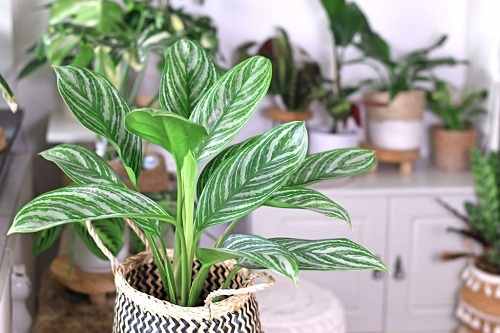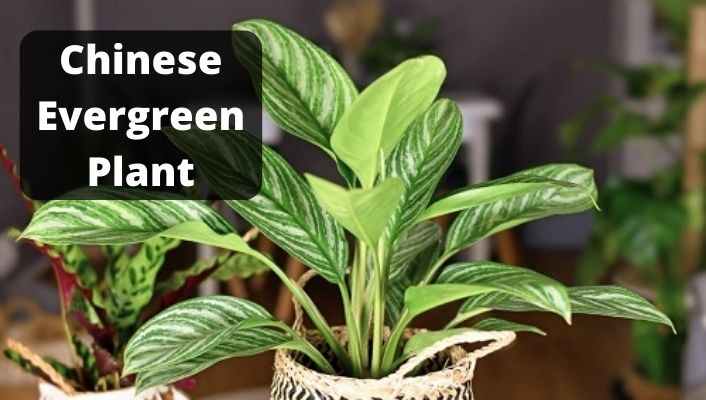If you want to pop in your decorative home game and are a plant lover, go for a Chinese evergreen plant. Surely this will enhance the look of your home or office. This plant comes in a variety of colors and varicolored patterns.
Chinese evergreen is a beautiful low-light indoor plant. For even beginners, it is very easy to grow this plant. It’s one of the best foliage plants for purifying room air toxins such as benzene and formaldehyde.
So if you are lazy or too busy, give extra attention to your plants. If you want a great-looking plant for your home, jump right into the following article.
Post Contents
Chinese Evergreen Care and Growing:
We will cover all the knowledge related to this plant, and in the end, you’ll be rewarded with a long-lasting, stable houseplant that will not outgrow its pot anytime soon. Firstly, let’s talk about the varieties and types of Chinese Evergreen plant:
- Frasher: This variety has milky green leaves with cream variegation and white petioles.
- Pseudobracteatum: The leaves of this type are covered in green-gray splotches, with veins outlined in white.
- White Rajah: There is a broad amount of white coloration on the leaves of this cultivar.
- Red Zircon: This variety has green leaves with pink blotchy sections in the center.
- Silver Bay: Silver tinges appear in the center of the predominantly green leaves of this cultivar.
- Maria: Dark green leaves are interrupted by silvery stripes on this shade-tolerant variety.

Moving on to the care tips of the plant for having a great, healthy, happy and beautiful Chinese Evergreen. That will surely catch everyone’s eyes.
Related Article: Philodendron Rojo Congo Care Guide
Chinese Evergreen Light Requirements:
Dark green varieties of Chinese evergreens can grow in-shade, while the variegated varieties require a bit more bright light. Take care not to expose any variety of the plant to direct sunlight, as the harsh rays can easily burn the delicate leaves.
Choosing the Soil:
Chinese evergreen doesn’t need a specific kind of soil. Use a well-draining peat-based potting mix with an acidic pH between 5.5 and 6.5. Add sand, perlite or bark to improve drainage. Make sure to plant your Chinese evergreen in a pot with wide-cut drainage holes at its base.
Watering Chinese Evergreen:
This plant thrives with a normal amount of watering. To achieve this balanced watering scenario, water your plant soundly, then allow it to dry completely before watering it again. Do this process in all seasons except winter.
Temperature and Humidity Requirements:
These plants do not like cold areas or temperatures below 70 degrees Fahrenheit. So make sure to keep your plant away from windows or vents that allow the flow of cool temperatures. The warmer the spot you can find, the better it will grow.
You can increase the humidity level of Chinese evergreens by using a room humidifier, misting plants frequently, or setting pots on a shallow tray filled with pebbles and water. Chinese evergreen plant prefer moist air with a humidity level of 60 to 70%. Keep pots out of standing water and keep them in a humid room like the kitchen or bathroom.
Chinese Evergreen Fertilizer:
Spring and summer are the best times to apply a balanced liquid houseplant fertilizer. For best results, feed your Chinese evergreen with slow-release pellets or liquid fertilizer at the beginning and end of its growing season. Avoid fertilizing in winter when plants are semi-dormant.

Related Article: Cucumber Plant Stages of Growth
Propagating:
For Chinese evergreen propagation, root division is the easiest method. You can do so during the summer when temperatures are warmest. Separate a clump by gently teasing the roots (this plant likes to be roots bound, so move slowly). Keeping both plants moist is important now that you have two separate plants.
Secondly, they can be propagated using the method of stem cuttings. This can be done using a disinfected, sharp cutting tool to take a stem from the mother plant several inches long and then plant it. The roots should form in three to four weeks.
Pests and Diseases:
Chinese evergreens are rarely attacked by pests or diseases, but they sometimes pick up common houseplant issues like scale, mealybugs, or spider mites. It is possible to treat these with an insecticide or neem oil.
Most of the issues arise because the plant is kept too moist. The fungal problems and root rot are typical problems of an over-watered Chinese evergreen.
Chinese Evergreen Potting & Repotting:
Blending in sand or perlite can be a good idea to improve drainage. Any material will do for a pot, though it’s common to use a decorative ceramic or clay pot with good drainage.
Remove plants from their pots and replenish them with fresh soil every 2 to 3 years in spring or whenever they appear overgrown or root-bound. Plants prefer to be slightly pot-bound.
Related Article: Growing Medium for Plants
Problems and Solutions:
1) Yellow leaves can indicate over-watering or under-watering. Keep plants evenly moist and allow them to dry out in between watering. Yellow leaves can also be a sign of copper deficiency. Make sure to fertilize plants properly.
Moreover, the soil should be drier rather than overly moist for these plants. To prevent root rot, let the top inch of soil dry out before watering. Depending on the size of the pot (around 10 to 12 inches in diameter), allow more of the soil to dry out.
2) Brown leaf tips may be caused by a soil buildup of salt, chlorine, or fluoride. Repot plants in fresh soil and use distilled water to irrigate plants. Make sure plants are well watered before fertilizing.
3) Brown leaves can result from low air humidity, cold drafts or under-watering. Raise room humidity, move plants away from drafty areas, and ensure plants get enough water.
4) Scorched leaves are caused by direct sunlight. Remove burned leaves and move plants to a spot with better lighting conditions, such as bright indirect light.
5) Temperature changes should be supervised as the plant prefers warm, draft-free spots.
6) Low humidity shouldn’t happen. With misting, your plant may require more humidity.
7) Underwatering the plant is dangerous because overly dry soil will affect the leaves. Allow the plant to recover from a watering by slowly watering it. Remove dry, crisp leaves.
Amazing Ideas to Display Chinese Evergreen:
- Plant it in a colorful ceramic pot and display it in a shady place during summer.
- Place a smaller plant in a bathroom on a shelf where it will benefit from the added room humidity.
- Decorate a dining room table with Chinese evergreens as a centerpiece.
- Place on a plant stand next to your bed for air cleansing benefits while you sleep, along with decor.
- Display a larger specimen on the floor of a home entryway or office lobby, but in the shade.
FAQs:
Is Chinese evergreen easy to care for?
They are very easy houseplants to grow. Best of all, they don’t like full sun, so they’re perfect for almost any room in your home, especially if window light is a trade good.
How fast does Chinese evergreen grow?
Chinese evergreen is a slow-growing plant, which means repotting is necessary every two to three years.
How often do you water a Chinese evergreen plant?
Soil should be kept moist but not soggy. Allow to dry out in between watering. It’s time to water if the soil is dry two inches down. Water plants less frequently during winter when they are semi-dormant.
How much light does a Chinese evergreen need?
Provide low to bright indirect light. Varieties with darker green leaves can tolerate dimmer conditions, while those with light or colorful variegation require brighter light to retain their colors and patterns. Direct sunlight can burn plants’ leaves. Avoid placing plants in direct sunlight.
Read More About Plants:

